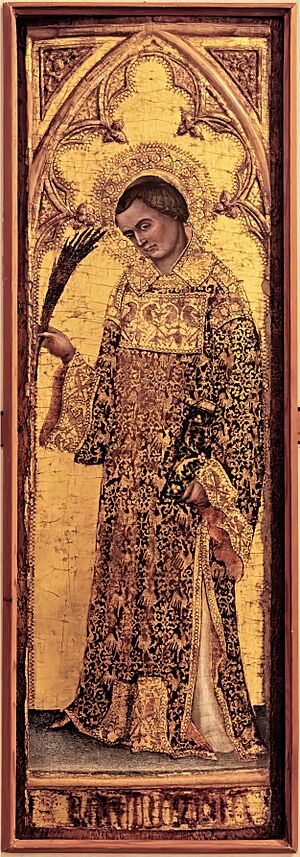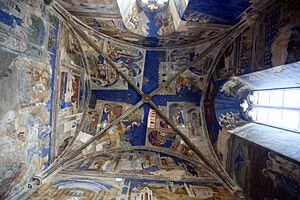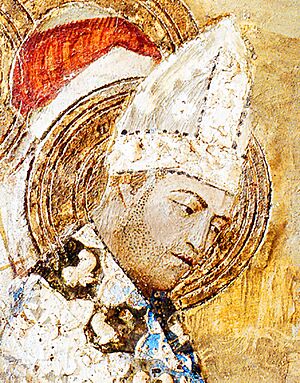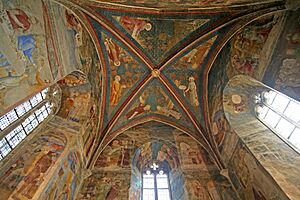Matteo Giovanetti facts for kids
Matteo Giovannetti (born around 1322 in Viterbo, Latium – died 1368) was a talented Italian painter. He spent most of his career working in Avignon, France, as part of the Pope's official group of artists. Some people think his painting style was similar to that of another famous artist, Simone Martini. However, there is no proof they ever met. It's more likely that Matteo learned a style popular in Siena, Italy, during his art training.
Contents
Who Was Matteo Giovannetti?
Matteo Giovannetti was an important painter from the 14th century. He is known for his beautiful frescoes, which are paintings made directly onto wet plaster walls. His work helped decorate some of the most important buildings of his time.
Working for the Pope
Matteo was invited to Avignon by Pope Clement VI. The Pope wanted him to help decorate the Palais des Papes, which was the Pope's grand palace in Avignon. Matteo was in charge of many other painters from all over Europe, leading them in these big projects.
He started painting the Saint-Martial chapel on October 13, 1344. This small chapel was connected to the large dining hall, known as the Grand Tinel. He finished this chapel by September 1, 1345. From January 9 to September 24, 1345, he also decorated the Saint-Michel oratory, which is a small prayer room. In November 1345, he began painting the frescoes in the Grand Tinel, finishing them in April 1346. Later, in 1347, from July 12 to October 26, he worked on a special meeting room and then on the Saint-Jean chapel.
Painting the Chapels
Matteo Giovannetti's most famous works are the frescoes in the chapels of the Papal Palace. These paintings tell important stories and show his unique artistic style.
The Saint-Martial Chapel's Stories
The Saint-Martial chapel is on the second floor of the palace. It is filled with paintings that tell the life story of Saint Martial. Giovannetti worked on these paintings between 1344 and 1345. To understand the story, you read the scenes from the top of the walls downwards.
The very top parts of the chapel's ceiling show thirteen scenes from Saint Martial's early life. These paintings show him meeting Christ's teachings when he was young and his baptism. They also show Christ preaching and fishing. Other scenes include Christ appearing to Peter, sending Martial to spread Christian teachings in Gaul (an old name for parts of France). You can also see Martial being sent with two friends to Gaul, receiving a special staff from Saint Peter, and healing the daughter of Arnulfus. There are also scenes of him bringing Nerva's son back to life, baptizing people in Toulx, and a miracle in Ahun. Other paintings show him helping people by casting out a demon and healing a person who could not walk.
The next section down has seven more scenes across four panels. These include the stories of André and Aurelian being brought back to life. There is also the story of Saint Valerie in Limoges, including her journey to heaven. Other panels show the story of Duke Etienne and one of his officers, Hildebert, being brought back to life. Finally, there are scenes of idols being destroyed in Bordeaux, the healing of Sigibertus, the count of Bordeaux, and a fire being put out.
The middle section of the chapel walls shows nine scenes in four panels. These include Christ appearing to Martial in Poitiers and the stories of Saints Peter and Paul. You can also see the special ceremony for Aurelian of Limoges and the creation of thirteen churches in Gaul. Other scenes show Christ appearing to announce Martial's death, Saint Valerie offering her head to Martial, and then Martial's death. The last scenes show his funeral procession and sick people being healed by touching his burial cloth. This part of the wall is closer to the ground, so it is not as well preserved as the higher parts. The lowest part of the walls, just above the floor, has decorative patterns.
The Saint-Jean Chapel's Art
Between 1347 and 1348, Matteo Giovannetti also worked on the Saint-Jean chapel. This chapel is located directly below the Saint-Martial chapel. You can enter it from the Consistory Hall, which is a meeting room built by Pope Benedict XII. Just like in the Saint-Martial chapel, you read the stories from top to bottom. However, in this chapel, there are two stories told at the same time. The south and east walls tell the story of John the Baptist. The north and west walls tell the story of Saint John the Evangelist.
The main stories begin in the upper part of the walls. The very top parts of the ceiling are dedicated to showing the parents of these two saints. For John the Baptist, you can see his mother Saint Elizabeth and his father Saint Zachary. For Saint John the Evangelist, his mother Saint Mary Salome and his father Saint Zebedee are shown. In total, eight important figures are painted on the ceilings of this chapel.
Images for kids













